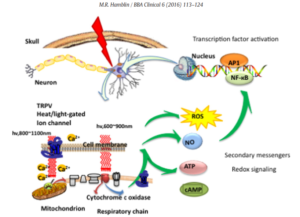
Photobiomodulation (PBM) describes the use of red or near-infrared light to stimulate, heal, regenerate, and protect tissue that has either been injured, is degenerating, or else is at risk of dying. One of the organ systems of the human body that is most necessary to life, and whose optimum functioning is most worried about by humankind in general, is the brain. The brain suffers from many different disorders that can be classified into three broad groupings: traumatic events (stroke, traumatic brain injury, and global ischemia), degenerative diseases (dementia, Alzheimer’s and Parkinson’s), and psychiatric disorders (depression, anxiety, post-traumatic stress disorder). There is some evidence that all these seemingly diverse conditions can be beneficially affected by applying light to the head. There is even the possibility that PBM could be used for cognitive enhancement in normal healthy people. In this transcranial PBM (tPBM) application, near-infrared (NIR) light is often applied to the forehead because of the better penetration (no hair, longer wavelength). Some workers have used lasers, but recently the introduction of inexpensive light-emitting diode (LED) arrays has allowed the development of light-emitting helmets or “brain caps”. This review will cover the mechanisms of action of photobiomodulation to the brain, and summarise some of the key pre-clinical studies and clinical trials that have been undertaken for diverse brain disorders.
© 2016 The Authors. Published by Elsevier B.V. This is an open-access article under the CC BY license.
Michael R. Hamblin. Wellman Center for Photomedicine, Massachusetts General Hospital, Boston, MA 02114, USA Department of Dermatology, Harvard Medical School, Boston, MA 02115, USA Harvard-MIT Division of Health Sciences and Technology, Cambridge, MA 02139, USA
View photo-modulation products in our shop http://atmans.com.au/product-category/infrared-photomodulation/
Download the full article http://atmans.com.au/shining-light-on-the-head/
